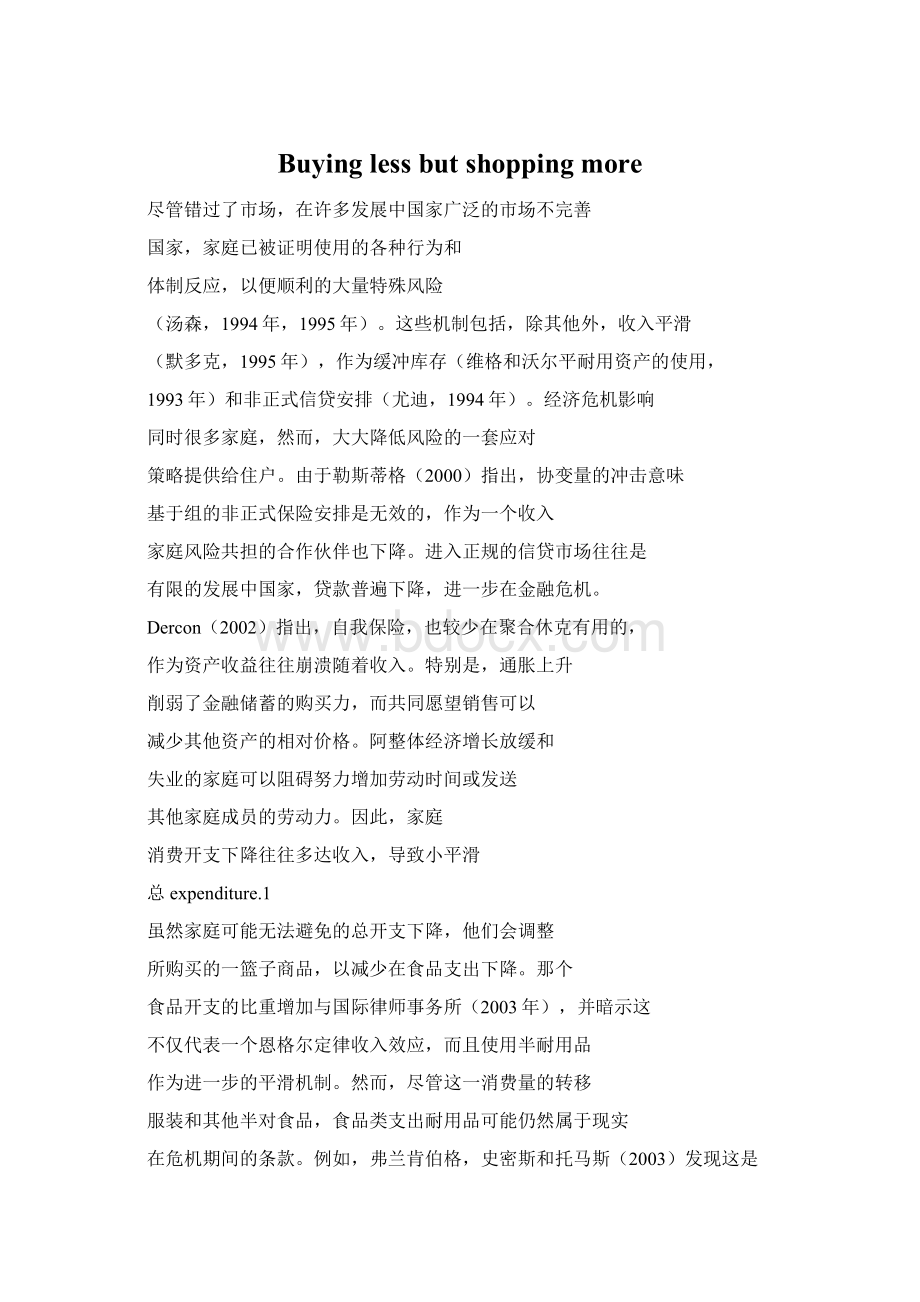Buying less but shopping more.docx
《Buying less but shopping more.docx》由会员分享,可在线阅读,更多相关《Buying less but shopping more.docx(39页珍藏版)》请在冰豆网上搜索。

Buyinglessbutshoppingmore
尽管错过了市场,在许多发展中国家广泛的市场不完善
国家,家庭已被证明使用的各种行为和
体制反应,以便顺利的大量特殊风险
(汤森,1994年,1995年)。
这些机制包括,除其他外,收入平滑
(默多克,1995年),作为缓冲库存(维格和沃尔平耐用资产的使用,
1993年)和非正式信贷安排(尤迪,1994年)。
经济危机影响
同时很多家庭,然而,大大降低风险的一套应对
策略提供给住户。
由于勒斯蒂格(2000)指出,协变量的冲击意味
基于组的非正式保险安排是无效的,作为一个收入
家庭风险共担的合作伙伴也下降。
进入正规的信贷市场往往是
有限的发展中国家,贷款普遍下降,进一步在金融危机。
Dercon(2002)指出,自我保险,也较少在聚合休克有用的,
作为资产收益往往崩溃随着收入。
特别是,通胀上升
削弱了金融储蓄的购买力,而共同愿望销售可以
减少其他资产的相对价格。
阿整体经济增长放缓和
失业的家庭可以阻碍努力增加劳动时间或发送
其他家庭成员的劳动力。
因此,家庭
消费开支下降往往多达收入,导致小平滑
总expenditure.1
虽然家庭可能无法避免的总开支下降,他们会调整
所购买的一篮子商品,以减少在食品支出下降。
那个
食品开支的比重增加与国际律师事务所(2003年),并暗示这
不仅代表一个恩格尔定律收入效应,而且使用半耐用品
作为进一步的平滑机制。
然而,尽管这一消费量的转移
服装和其他半对食品,食品类支出耐用品可能仍然属于现实
在危机期间的条款。
例如,弗兰肯伯格,史密斯和托马斯(2003)发现这是
在印尼期间发生危机,而国际律师事务所(2003年)显示,在这种模式墨西哥比索危机。
以及代之间的食物和其他物品,包括
文件还发现,消费者在食品分配,投入更大的
食品支出的份额基本主食危机期间。
除了调整消费比重,以保障食品开支水平,
住户也可以调整的冲击,采取各种行动影响多少食物1
由于支出水平可以买到。
特别是,家庭可能改变频率
他们的采购,在这些采购是由商店,和项目的质量
购买。
标准支出调查通常提供的这些资料不多
消费者行为方面,因此,这种机制的使用
应对危机很大程度上被忽视了。
在本文中,我们使用高频
家庭支出数据登记所有的购买,每10天的样本期
产品,研究消费者在调整范围内对2002年这些行动
在阿根廷金融危机。
尽管在危机中真正的一切开支,我们发现一
7购物频率增长,与购物的消费者多天
上周在更多种类的商店。
在购物时通过频率增加
消费者花更多的低质量的产品在商店购物的时间传统
所使用的更多的穷人。
消费者还发现,减少了产品的质量
购买,并把高档品牌下降5个项目的支出份额
在2002点。
我们研究是否在购物频率的变化相当于观察
调整收入下降,或在劳动时间,通货膨胀,价格变化的结果
分散性和流动性危机期间。
虽然这些其他因素发挥作用,我们
找到的购物频率,即贫穷大的收入效应的证据
消费者购物更经常地购买特定数量的产品。
在面临深
经济衰退,越来越多的家庭购物频率允许使用非市场的劳动力的
搜索活动和被发现是最普遍使用的调整机制之一
消费者在危机。
这种搜索行为被发现与
消费者付出同样的产品价格较低,并转移他们的一些
支出由高向低质量的品牌。
因此,给定的支出水平
能够购买更多的商品数量。
我们的计算表明,在回应
在危机期间经历的收入下降,消费者使用这样的调整
机制,保存,平均约百分之四的食物费用,
美容和清洁产品的开支,从而减轻了对百分之四十
实际支出下降,这些产品。
在相关的研究,阿吉亚尔和赫斯特(2004年)认为,退休消费
在美国,这是退休让人不解的是伴随着大幅下降
支出,可占者在家里粮食花费的时间大幅上升
编制和增加花费的时间购物。
他们利用截面数据大
人口数量和健康对照,研究在粮食量的变化
饮用退休。
我们有详细的高频率数据购物行为
和个人的价格数据,使我们能够提供直接的证据表明增加
购物时间,给消费者带来的好处。
我们发现,增加购物帮助
消费者减轻了总收入的冲击补充其家中发现,
生产可以帮助平滑预期活动支持了其总
结论是,支出可能是误导消费的措施。
除了其作为危机缓解机制的重要性,在购物增加
频率可能有助于解释为什么通货膨胀谜惊人
大幅度贬值后低(奥布斯特菲尔德和Rogoff,2000)。
伯斯坦,艾肯鲍姆,和
雷贝洛(2004)认为,非流通股部分的分销成本和
从高品质的进口低质量的替代本地产品解释这种低过手。
我们的结果证实了质量替代的存在和增加,增加的
在购物频率可能会降低销售成本的能力,通过增加通过
价格。
本文的其余部分结构如下。
第2款规定的一般
总观目前在阿根廷之前和期间的宏观经济条件
危机。
第3节讨论了家庭支出LatinPanel,获得的数据1
市场研究公司。
第4节,然后详细消费者应对危机的条件
在开支的变动,质量和购物行为。
第5检查数
说明在消费行为的这些变化。
第6条计算的收益
增加购物次数和第7总结。
BUYINGLESS,BUTSHOPPINGMORE:
CHANGESINCONSUMPTIONPATTERNSDURINGA
CRISIS*
DavidMcKenzie#
StanfordUniversity
ErnestoSchargrodsky##
UniversidadTorcuatoDiTella
February11,2005
Abstract
Marketresearchdataareutilizedtoexaminetheuseofchangesinshoppingbehaviorasa
methodofmitigatingtheeffectsofthe2002Argentineeconomiccrisis.Althoughthe
totalquantityandrealvalueofgoodspurchasedfellduringthecrisis,consumersare
foundtobespendingmoredaysshopping.Thisincreaseinshoppingfrequencyoccurs
throughconsumerspurchasinglower-qualitygoodsfromawidervarietyofshopping
channels.Thispaperprovidesthefirstestimatesofthemagnitudeofsucheffectsduringa
recession,andsuggeststhatthisincreaseinshoppingfrequencycanbeanimportant
copingmechanismforhouseholds.Shoppingmoreoftenisshowntoenablehouseholds
toseekoutlowerpricesandlocatesubstitutes,allowingagivenlevelofexpenditureto
buymoregoods.
Keywords:
crisismitigation;aggregateshocks;non-marketlabor
JELclassificationcodes:
D12,J22,O12.
*ThankstoSebastianGimenezofLatinPanelforhelpwiththemarketresearchdatausedinthisstudy,to
NestorDeCesareforcorralitoexpertise,toMatiasCattaneoandSebastianCalonicoforextremelyvaluable
researchassistance,andtocommentsfromseminarparticipantsattheBayAreaDevelopmentDay,
BREAD,DiTella,NEUDC2004,SITE2004,UCLA,Virginia,andVirginiaTech.Financialsupportwas
providedbyaSIEPRseedgrant.
#DepartmentofEconomics,StanfordUniversity,579SerraMall,Stanford,CA94305-6072;E-mail:
mcken@stanford.edu;Fax:
(650)725-5702;Phone:
(650)723-9276.Partofthisresearchwasconducted
whileMcKenziewasvisitingthePovertyResearchGroupoftheWorldBankDECRG,whosehospitalityis
gratefullyacknowledged.
##UniversidadTorcuatoDiTella,Miñones2177,(1428)BuenosAires,Argentina;E-mail:
eschargr@utdt.edu;Fax:
(54-11)4783-3220;Phone:
(54-11)4783-3112.
-1-
1.Introduction
Despitemissingmarketsandwidespreadmarketimperfectionsinmanydeveloping
countries,householdshavebeenshowntouseawidevarietyofbehavioraland
institutionalresponsesinordertosmoothalargeamountofidiosyncraticrisks
(Townsend,1994,1995).Thesemechanismsinclude,amongothers,incomesmoothing
(Morduch,1995),theuseofdurableassetsasbufferstocks(RosenzweigandWolpin,
1993)andinformalcreditarrangements(Udry,1994).Economiccriseswhichaffect
manyhouseholdssimultaneously,however,greatlyreducethesetofrisk-coping
strategiesavailabletohouseholds.AsLustig(2000)notes,covariateshocksmeanthat
group-basedinformalinsurancearrangementsareineffective,astheincomesofa
household’srisk-poolingpartnersalsofall.Accesstoformalcreditmarketsisoften
limitedindevelopingcountries,andlendinggenerallyfallsfurtherduringfinancialcrisis.
Dercon(2002)observesthatself-insuranceisalsolessusefulduringanaggregateshock,
asreturnsonassetsoftencollapsealongwithincomes.Inparticular,risinginflationcan
erodethepurchasingpoweroffinancialsavings,whileacommondesiretosellcan
reducetherelativepriceofotherassets.Ageneraleconomicslowdownandrising
unemploymentcanstymietheeffortsofhouseholdstoincreaselaborhoursorsend
additionalhouseholdmemberstothelaborforce.Asaconsequence,household
consumptionexpenditureoftenfallsbyasmuchasincome,resultinginlittlesmoothing
oftotalexpenditure.1
Althoughhouseholdsmaynotbeabletopreventafallintotalexpenditure,theydoadjust
thebasketofgoodspurchasedinordertoreducethefallinfoodexpenditure.The
expenditureshareonfoodincreases,withMcKenzie(2003)suggestingthatthis
representsnotonlyanEngel’sLawincomeeffect,butalsotheuseofsemi-durablegoods
asafurthersmoothingmechanism.Nevertheless,despitethisshiftinconsumptionfrom
clothingandothersemi-durablestowardsfood,expenditureonfoodmaystillfallinreal
termsduringacrisis.Forexample,Frankenberg,SmithandThomas(2003)findthistobe
thecaseduringtheIndonesiancrisis,whileMcKenzie(2003)showsthispatternduring
1See,forexample,Thomasetal.(1999)andStraussetal.(2004)onIndonesia,Skoufias(2003)onRussia,
McKenzie(2003)onMexico,andPaxsonandSchady(2004)onPeru.
-2-
theMexicanpesocrisis.Aswellassubstitutingbetweenfoodandotheritems,both
papersfindthatconsumersfurtherreallocateacrossfoodproducts,devotingalarger
shareoffoodexpendituretobasicstaplesduringthecrisis.
Inadditiontoreallocatingconsumptionsharestoprotecttheleveloffoodexpenditure,
householdsmayalsoadjusttoashockbytakingactionswhichaffecthowmuchfooda
givenlevelofexpenditurecanbuy.Inparticular,householdsmaychangethefrequency
oftheirpurchases,thestoresatwhichthesepurchasesaremade,andthequalityofitems
purchased.Standardexpendituresurveysgenerallyprovidelittleinformationonthese
aspectsofconsumerbehavior,andasaconsequence,theuseofsuchmechanismsin
responsetocrisishasbeenlargelyunstudied.Inthispaper,weusehighfrequency
householdexpendituredataregisteringallthepurchasesevery10-dayperiodofasample
ofproducts,tostudytheseactionsinthecontextofconsumeradjustmenttothe2002
financialcrisisinArgentina.Despiterealexpenditurefallingduringthecrisis,wefinda
sevenpercentincreaseinshoppingfrequency,withconsumersshoppingmoredaysa
weekandatawidervarietyofstores.Theincreaseinshoppingfrequencyoccursthrough
consumersspendingmoretimeshoppingforlow-qualityproductsatstorestraditionally
usedmorebythepoor.Consumersarealsofoundtohavereducedthequalityofproducts
purchased,withtheexpenditureshareonpremiumbranditemsfallingfivepercentage
pointsin2002.
Weexaminewhethertheobservedchangeinshoppingfrequencyrepresentsan
adjustmenttofallingincome,ortheresultofchangesinlaborhours,inflation,price
dispersion,andliquidityduringthecrisis.Althoughtheseotherfactorsplayarole,we
findevidenceforalargeincomeeffectonshoppingfrequency,wherebypoorer
consumersshopmoreoftentobuyagivenquantityofproducts.Inthefaceofadeep
recession,increasingshoppingfrequencyallowshouseholdstousenon-marketlaborfor
searchactivityandisfoundtobeoneofthemostprevalentadjustmentmechanismsused
byconsumersduringthecrisis.Suchsearchbehaviorisfoundtobeassociatedwith
consumerspayinglowerpricesforthesameproducts,andshiftingsomeoftheir
expenditurefromhightolow-qualitybrands.Asaresult,agivenlevelofexpenditureis
-3-
abletopurchasealargerquantityofgoods.Ourcalculationssuggestthatinresponseto
thefallinincomeexperiencedduringthecrisis,consumersusedthisadjustment
mechanismtosave,onaverage,approximatelyfourpercentofthecostoftheirfood,
beauty,andcleaningproductexpenditure,therebymitigatinguptofortypercentofthe
fallinrealexpenditureintheseproducts.
Inrelatedresearch,AguiarandHurst(2004)arguethattheretirementconsumption
puzzleintheUnitedStates,whichisthatretirementisaccompaniedbyadramaticdecline
inexpenditures,canbeaccountedforbythelargeriseintimespentonhomefood
preparationandincreasedtimespentshopping.Theyusecross-sectionaldatawithalarge
numberofdemographicandhealthcontrolstolookatchangesinquantitiesoffood
consumedwithretirement.Wehavedetailedhigh-frequencydataonshoppingbehavior
and